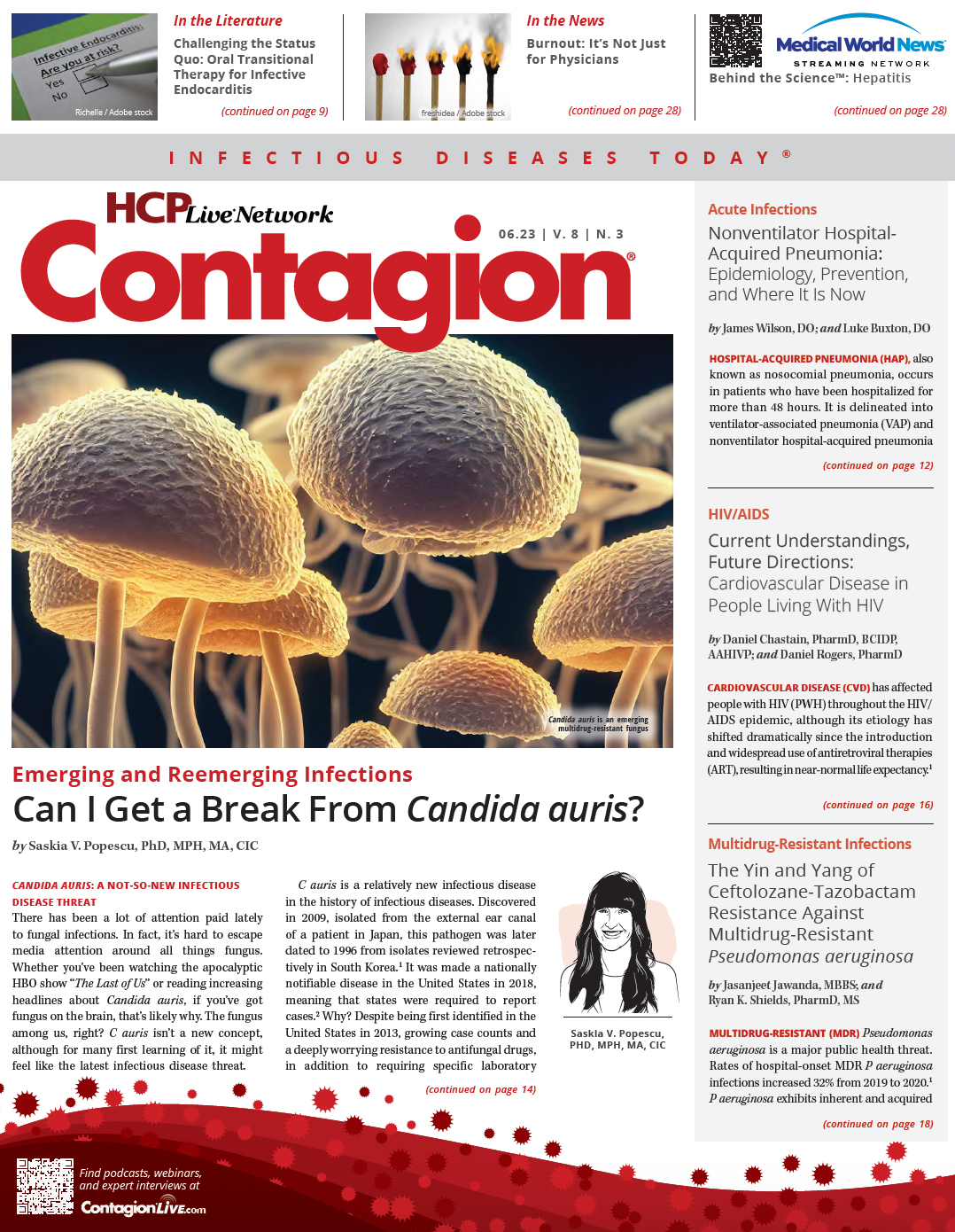Bivalent COVID-19 Boosters: Dosing Intervals, Boosting Strategies, and Coadministration With Influenza Vaccines
"It does take the immune system a while to build up antibodies and recover," said Madeline King-Patel, PharmD, BCIDP, "So you don't want to give the vaccines too close to each other, or you're not going to get the full benefits."

Click here to watch the Peer Exchange video series, "Recent Approvals in Vaccination Against SARS-CoV-2 and the Omicron Subvariants."
Uptake of the bivalent COVID-19 vaccine booster has been suboptimal in many communities, and discussing the boosters and the safety and efficacy of heterologous boosting strategies with community members can encourage them to receive the shots, according to panelists in a recent Contagion Peer Exchange episode moderated by Rodney E. Rohde, PhD, MS, SM(ASCP), MB(ASCP), SV(ASCP), FACSc.
The panelists discussed strategies to ensure accurate dosing for the different bivalent SARS-CoV-2 boosters and for coadministration with influenza vaccines.
CDC AND FDA RECOMMENDATIONS
The Centers for Disease Control and Prevention (CDC) and US Food and Drug Administration (FDA) state that bivalent SARS-CoV-2 boosters should be administered at least 2 months after completing the primary series or receiving a monovalent booster in individuals 6 months or older who are not immunocompromised.1,2
Talking to patients helps them understand how the body develops immunity and the rationale for the 2-month interval between the primary series and boosters, according to Madeline King-Patel, PharmD, BCIDP. “When they get that first shot of the COVID-19 vaccine, that’s priming their immune system,” she said. “The subsequent injections we’re giving them, we’re making the immune system more robust. It’s important to point out that if you don’t wait 2 months, you’re not going to get as robust of an immune response as you would if you do wait that long. It does take the immune system a while to build up antibodies and recover, so you don’t want to give the vaccines too close to each other, or you’re not going to get the full benefits.”
Because she works primarily with minority communities, Jacinda C. AbdulMutakabbir, PharmD, MPH, also discusses the disproportionate impact of COVID-19 and the proportionately lower uptake of the SARS-CoV-2 vaccines among individuals in these communities. She added that a 3-month interval between completion of the primary series and administration of the booster may be acceptable and would allow for optimal development of antibody protection for patients younger than 50 years who are not immunocompromised.
Although the science behind the development of immunity is important to consider, practical factors, such as exposure among children at school and reduced mask wearing in the community, also need to be considered in the effort to maximize uptake of the SARS-CoV-2 booster, according to Wendy Wright, DNP, ANP-BC, FNP-BC, FAANP, FAAN, FNAP. “This is a virus that’s out there,” she said. “It’s circulating. There are more and more infections. The thought was, ‘Can we get this on board as these kids are going back to school and as we’re heading into those winter months to give people optimal protection when they’re inside, unmasked because people aren’t wearing them, and give them some protection to get them through these winter months?’”
Rohde added that it is important for individuals to ask their physician or other immunization provider about vaccine schedules and testing for SARS-CoV-2, although many clinicians may struggle with the rapid evolution of the knowledge and recommendations around COVID-19. “The country is in this moment where they don’t like the gray answer,” he said. “We’re a society of yes, no, tell me what to do. With virus[es], that isn’t the way they work. They’re going to change, they’re going to do different things, and as soon as we think we have the answer, now we have a different thing to worry about. This has been a constant reminder for people to understand that testing is part of controlling a pandemic, and if you don’t understand that the virus is changing, your tests can start failing and produce false positives and false negatives. The science has to be there; it’s just figuring out a way to communicate that type of information.”
INFLUENZA VACCINATION WITH SARS-COV-2 MRNA BOOSTER SHOTS
To reduce the likelihood of giving the wrong dose of a given vaccine, Wright’s clinic gives the Moderna and Pfizer vaccines on Mondays (“Moderna Mondays”) and Fridays (“Pfizer Fridays”). She added that both pharmacists and primary care providers are overburdened with their respective workloads and that creative strategies are needed within the health care system to maximize vaccine uptake.
Abdul-Mutakabbir noted that the Third Amendment to Declaration Under the Public Readiness and Emergency Preparedness Act for Medical Countermeasures Against COVID-19 allows pharmacists to vaccinate individuals 3 years or older, and that the majority of individuals who have received vaccines have received them from pharmacists.3 To minimize the likelihood of wasting doses, Abdul-Mutakabbir uses the Pfizer vaccine when vaccinating in the community because each vial has fewer doses per vial compared with the Moderna vaccine.
The safety and efficacy of heterologous vaccination are common worries among members of the community, and Abdul-Mutakabbir said that she recommends messenger RNA (mRNA) boosters for patients who received the initial Johnson & Johnson vaccine because this vaccine appeared to yield lower immunogenicity compared with the mRNA vaccines. However, she also stressed the importance of empowering the potential vaccine recipient with knowledge about their options and choices.
“I want them to know the reason I’m not bringing Moderna, but that I’m not compromising their protection,” she said. “We have so many different doses. We have so many different caps at this point: 17 different colors. It becomes a matter of, ‘How can I do this and maximize the vaccinations? How do we keep it safe?’ It becomes that comfortable place when I have only the Pfizer COVID-19 vaccine. If I bring the influenza vaccine with me, it becomes a bit easier to have to manage only those 2 different types of vaccines.”
Because the mRNA SARS-CoV-2 vaccines are inactivated, they can be administered at the same time as other vaccines, including the influenza vaccine, although Abdul-Mutakabbir advises patients to get the vaccines in different arms. King added that many individuals who come into her clinic prefer to receive the COVID-19 and influenza vaccines on the same day. “A lot of people say, ‘If I’m going to feel bad, I want to feel bad only once,’” she said. King added that it is also a good opportunity to remind vaccine recipients that the arm soreness and fatigue are due to the immune system response to the vaccines and not because they have acquired an infection from the vaccine.
Rohde concluded that patients should be encouraged to take acetaminophen as needed to improve their comfort level after vaccinations. “I tell people all the time, ‘That’s why you’re taking a vaccine. It’s also why we take medication. You don’t need to suffer. It’s OK if you’re doing it correctly according to the directions, and things will be a little easier for you.’ That’s important,” Rohde said.

